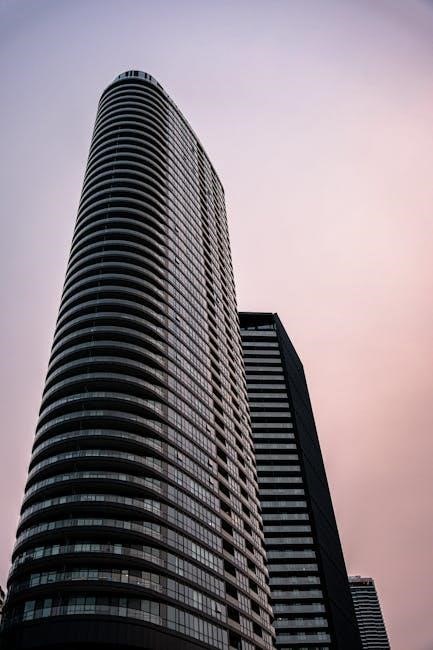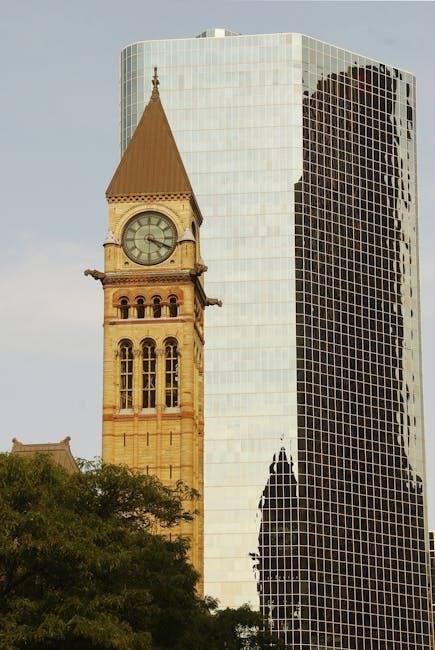
The 2012 Ontario Building Code is a comprehensive regulation under the Building Code Act, 1992, designed to promote public safety, sustainability, and accessibility in construction. It outlines standards for building design, materials, and occupancy, ensuring compliance with current safety and efficiency requirements across Ontario.
Overview of the 2012 Ontario Building Code
The 2012 Ontario Building Code is a regulation under the Building Code Act, 1992, effective January 1, 2014. It establishes minimum standards for building design, construction, and occupancy, focusing on accessibility, fire safety, energy efficiency, and structural integrity. Compliance ensures public safety and sustainability, with updates reflecting current construction practices and enforcement through regulatory bodies.
Importance of the Building Code in Ontario
The 2012 Ontario Building Code is crucial for safeguarding public safety, health, and welfare. It ensures buildings are constructed to withstand hazards, promotes energy efficiency, and enforces accessibility standards. Compliance with the Code protects property values, supports environmental sustainability, and streamlines construction processes, making it a cornerstone of Ontario’s built environment and regulatory framework.
Structure and Organization of the 2012 Ontario Building Code
The 2012 Ontario Building Code is organized into two main volumes, with Volume 1 focusing on governance and Volume 2 detailing technical requirements. It is structured into parts addressing administrative provisions, building requirements, and compliance methods, ensuring clarity and accessibility for users. The Code’s systematic approach facilitates easy navigation and application across various construction projects in Ontario.

Key Changes and Updates in the 2012 Edition
The 2012 Ontario Building Code introduced enhanced energy efficiency standards, updated fire safety provisions, and improved accessibility requirements, reflecting modern construction practices and safety priorities.
Major Amendments Compared to Previous Editions
The 2012 Ontario Building Code introduced significant updates, including enhanced energy efficiency requirements, improved fire safety measures, and expanded accessibility standards. It also strengthened provisions for structural integrity and updated compliance pathways to reflect modern construction practices and materials, ensuring safer and more sustainable buildings across Ontario.
Enhanced Energy Efficiency Requirements
The 2012 Ontario Building Code introduced stricter energy efficiency standards, targeting reduced energy consumption and greenhouse gas emissions. Requirements for insulation, windows, HVAC systems, and hot water heaters were strengthened. These updates applied to detached homes, semi-detached homes, townhouses, and small apartment buildings, promoting sustainable construction while balancing affordability and safety.
Updated Fire Safety Provisions
The 2012 Ontario Building Code strengthened fire safety measures, including fire resistance ratings for materials and updated fire suppression systems. It introduced enhanced requirements for smoke alarms, emergency lighting, and exit signage. These updates aim to improve occupant safety, reduce fire risks, and ensure compliance with modern fire protection standards across various building types in Ontario.
Fire Safety Requirements in the 2012 Ontario Building Code
The 2012 Ontario Building Code establishes fire safety standards, including fire resistance ratings for materials and structural integrity during fires. It ensures clear exit paths and emergency access, promoting occupant safety and compliance with modern fire protection practices.
Fire Resistance Ratings for Building Materials
The 2012 Ontario Building Code mandates fire resistance ratings for building materials and assemblies to ensure they can withstand fire exposure for specific durations. These ratings are critical for maintaining structural integrity during fires, safeguarding occupant evacuation, and limiting fire spread. Compliance with these standards is verified through testing by accredited laboratories, ensuring materials meet safety requirements for various building types and occupancies.
Fire Suppression Systems and Equipment
The 2012 Ontario Building Code requires the installation, inspection, and maintenance of fire suppression systems and equipment to ensure reliable performance in emergencies. These systems, including sprinklers and fire extinguishers, must meet specific design and installation standards tailored to building type and occupancy. Regular testing and maintenance are mandated to guarantee functionality and protect occupants from fire hazards effectively. Compliance ensures safety and minimizes potential fire-related risks.
Means of Egress and Emergency Lighting
The 2012 Ontario Building Code mandates clear and accessible means of egress, ensuring safe evacuation during emergencies. Emergency lighting must be installed to illuminate exit routes, with signage directing occupants to exits. These requirements ensure visibility and safe navigation, minimizing risks during power outages or low-visibility conditions. Compliance with these standards is critical for protecting building occupants and facilitating timely evacuations.
Energy Efficiency and Sustainability in the 2012 Code
The 2012 Ontario Building Code promotes energy efficiency and sustainability through enhanced standards for residential and commercial buildings, ensuring compliance with modern environmental and conservation practices.
Energy Efficiency Requirements for Residential Buildings
The 2012 Ontario Building Code mandates energy efficiency for detached homes, semi-detached homes, townhouses, and small apartment buildings. Requirements include energy-efficient insulation, windows, and HVAC systems. Builders must ensure compliance with specific standards to reduce energy consumption and meet environmental goals. An EnerGuide rating of 80 is often required, promoting sustainable residential construction practices across Ontario.
Sustainability Practices in Commercial Construction
The 2012 Ontario Building Code promotes sustainability in commercial buildings by requiring the use of recycled materials, low-VOC paints, and energy-efficient systems. It mandates high-performance insulation and water-conserving fixtures to reduce environmental impact. Builders must also consider renewable energy systems and design buildings to maximize natural light and ventilation, aligning with Ontario’s broader sustainability goals and reducing long-term operational costs.
Renewable Energy Systems and Their Compliance
The 2012 Ontario Building Code supports the integration of renewable energy systems, such as solar, wind, and geothermal technologies, in building design. Compliance requires these systems to meet specific performance and safety standards, ensuring they are installed correctly and efficiently. The code mandates certifications and inspections to verify system reliability and environmental benefits, promoting sustainable energy use in Ontario’s construction sector.

Accessibility Standards in the 2012 Ontario Building Code
The 2012 Ontario Building Code enforces accessibility standards to ensure buildings are inclusive and usable by everyone. It mandates barrier-free design, clear pathways, and adaptable features to promote universal access and safety for all occupants, reflecting Ontario’s commitment to inclusivity and equal opportunity in built environments.
Design Requirements for Accessible Buildings
The 2012 Ontario Building Code outlines specific design requirements for accessible buildings, including clear pathways, ramps, elevators, and tactile signage. These standards ensure that all buildings provide equal access for individuals with disabilities, promoting inclusivity and safety. The code mandates that architectural designs incorporate adaptable features, enabling seamless navigation and use of facilities for everyone.
Clear Path of Travel and Obstacle-Free Access
The 2012 Ontario Building Code emphasizes the importance of maintaining a clear path of travel, ensuring obstacle-free access for all users. This includes minimum corridor widths, proper door swings, and the removal of protruding objects. These requirements ensure safe and unimpeded movement, particularly for individuals with mobility aids, aligning with accessibility standards and enhancing overall building safety and functionality.
Adaptable Housing and Universal Design Principles
The 2012 Ontario Building Code promotes adaptable housing through flexible design, enabling homes to meet diverse needs over time. Features like adjustable countertops and removable walls allow modifications for accessibility. Universal design principles ensure inclusivity, with elements such as wide doorways and zero-step entrances, creating environments accessible to all ages and abilities, aligning with Ontario’s accessibility goals.

Construction Requirements for Different Building Types
The 2012 Ontario Building Code sets specific standards for residential, commercial, and industrial buildings, ensuring safety, sustainability, and accessibility. Requirements vary by building type to address unique structural and occupancy needs.
Residential Building Construction Standards
The 2012 Ontario Building Code outlines specific standards for residential construction, focusing on design, materials, and safety. Energy efficiency requirements apply to detached homes, semi-detached homes, townhouses, and small apartment buildings. Builders must achieve an EnerGuide rating of 80 or implement upgrades if not met. The code ensures safe and sustainable living environments, with detailed guidelines for compliance. The 2012 Building Code Compendium PDF provides comprehensive details for non-commercial use.
Commercial Building Construction Requirements
The 2012 Ontario Building Code sets rigorous standards for commercial buildings to ensure structural integrity, fire safety, and energy efficiency. It emphasizes sustainability practices, including energy-efficient systems and waste reduction. Accessibility is a key focus, with clear guidelines for barrier-free access. Compliance with these requirements is enforced by local authorities, ensuring safe and sustainable commercial environments. The 2012 Building Code PDF provides detailed specifications for commercial projects.
Industrial Building Safety and Design Standards
The 2012 Ontario Building Code mandates strict safety and design standards for industrial buildings to protect workers and equipment. Key requirements include fire-resistant materials, explosion-proof systems, and proper ventilation. The code also addresses structural integrity to handle heavy machinery and loads. Compliance ensures safe working environments and minimizes risks associated with industrial operations. Detailed specifications are outlined in the 2012 Ontario Building Code PDF for reference.

Legal and Enforcement Aspects of the Building Code
The Building Code Act, 1992 governs Ontario’s building regulations, imposing penalties for non-compliance and outlining a dispute resolution process. Access the 2012 Ontario Building Code PDF for details.
Authority and Enforcement of the Building Code Act, 1992
The Building Code Act, 1992 establishes the legal framework for enforcing Ontario’s building standards. The Ministry of Municipal Affairs and Housing oversees compliance, with penalties for violations. Authorities ensure adherence to the 2012 Ontario Building Code PDF, maintaining public safety and accountability in construction projects across the province.
Penalties for Non-Compliance
Non-compliance with the 2012 Ontario Building Code can result in significant penalties, including fines and legal actions. The Ministry of Municipal Affairs and Housing enforces these measures to ensure adherence to the regulations. Violations may lead to financial penalties and legal consequences, highlighting the importance of compliance to maintain public safety and structural integrity.
Dispute Resolution and Appeals Process
The 2012 Ontario Building Code provides a structured process for resolving disputes and appealing decisions. Individuals can challenge rulings through the Building Code Commission, which reviews cases to ensure compliance and fairness. This mechanism ensures that all parties have a clear pathway to address concerns, maintaining transparency and accountability within the regulatory framework of Ontario’s construction industry.

Obtaining the 2012 Ontario Building Code PDF
To access the 2012 Ontario Building Code PDF, visit the official Ontario government website at www.ontario.ca/buildingcode. Follow the provided steps to download the compendium for non-commercial use, ensuring compliance with licensing requirements.
Official Sources for the Building Code PDF
The 2012 Ontario Building Code PDF can be obtained from the official Ontario government website at www.ontario.ca/buildingcode; This is the primary and most reliable source for accessing the compendium. Additionally, the Ministry of Municipal Affairs and Housing provides direct links and instructions for downloading the document, ensuring authenticity and compliance with non-commercial use requirements.
Steps to Download the 2012 Building Code Compendium
To access the 2012 Ontario Building Code Compendium PDF, visit the official Ontario government website at www.ontario.ca/buildingcode. Navigate to the building code section, where you will find instructions to submit a request. After submission, follow the provided directions to download the document for non-commercial use, ensuring compliance with licensing requirements.
Non-Commercial Use and Licensing Requirements
The 2012 Ontario Building Code PDF is available for non-commercial use under specific licensing terms. Users must agree to terms restricting duplication and distribution for profit. Commercial use requires obtaining proper licenses from the Ontario government. Compliance with these requirements ensures legal access to the document while protecting intellectual property rights.
Case Studies and Practical Applications
The 2012 Ontario Building Code provides real-world applications, aiding professionals and municipalities in implementing standards. Case studies highlight successful code compliance in residential and commercial projects, ensuring safety and efficiency across Ontario.
Real-World Applications of the 2012 Building Code
The 2012 Ontario Building Code is widely applied in residential, commercial, and industrial projects, ensuring compliance with safety, energy efficiency, and accessibility standards. Real-world examples include its use in designing energy-efficient homes, fire-resistant commercial buildings, and accessible public spaces. These applications demonstrate how the code promotes sustainable development, enhances public safety, and supports the creation of inclusive environments across Ontario.
Challenges in Implementing the Code
Implementation of the 2012 Ontario Building Code faces challenges such as interpreting complex requirements, balancing costs with compliance, and addressing variations in local building practices. Additionally, keeping up with updates and ensuring all stakeholders are informed can be difficult. These challenges highlight the need for clear guidance and training to facilitate effective compliance across Ontario’s construction industry.
Success Stories in Code Compliance
The 2012 Ontario Building Code has enabled numerous success stories, showcasing effective compliance in residential and commercial projects. Case studies highlight how adherence to the code has enhanced safety, sustainability, and accessibility. Municipalities and developers report achieving high standards, demonstrating the code’s practical application. These successes underscore the code’s role in fostering safer, more efficient, and environmentally friendly communities across Ontario.

Training and Resources for Building Code Compliance

The 2012 Ontario Building Code offers various training programs, online resources, and workshops to help professionals understand and implement the regulations effectively.
Available Training Programs for Professionals
Professionals can access training programs tailored to the 2012 Ontario Building Code, offered by the Ministry of Municipal Affairs and Housing. These programs cover code compliance, energy efficiency, and accessibility standards, ensuring practitioners stay updated. Classroom sessions, online courses, and certification workshops are available, providing hands-on knowledge to navigate and implement the code effectively in various construction projects across Ontario.
Online Resources and Guides
The Ontario government provides online resources and guides for the 2012 Building Code, accessible at www.ontario.ca/buildingcode. These include detailed PDF documents, technical bulletins, and reference materials. Professionals can download the 2012 Building Code Compendium for non-commercial use, ensuring access to updated regulations, fire safety provisions, and energy efficiency standards. These resources facilitate compliance and understanding of the code’s requirements.
Workshops and Seminars on Code Updates
Workshops and seminars are offered to educate professionals on updates to the 2012 Ontario Building Code. These sessions, often hosted by the Ministry of Municipal Affairs and Housing, cover key amendments, energy efficiency, and fire safety. Attendees gain practical insights and resources to ensure compliance. Visit www.ontario.ca/buildingcode for schedules and registration details to stay informed on the latest code updates.

Frequently Asked Questions (FAQs)
FAQs address common inquiries about the 2012 Ontario Building Code PDF, including access methods, update notifications, and compliance requirements. Visit official sources for accurate information.
Common Questions About the 2012 Building Code
Common questions include how to access the 2012 Ontario Building Code PDF, understanding updates, and compliance requirements. Many inquire about fire resistance ratings, energy efficiency standards, and accessibility norms. Others seek clarification on enforcement processes and penalties for non-compliance. Additionally, questions arise about specific construction materials and design standards. Visit official sources for detailed answers and updates.
Clarifications on Specific Code Requirements
Clarifications often address fire resistance ratings, energy efficiency, and accessibility standards. Questions arise about specific materials, design elements, and compliance metrics. For instance, the code specifies fire resistance ratings for structural components and outlines energy efficiency targets. Additionally, inquiries focus on accessible pathways and universal design principles. Consulting official guidelines or experts is recommended for precise interpretations and applications;
Misconceptions and Myths About the Building Code

Common myths include the belief that the code is overly restrictive or only applies to new constructions. In reality, it ensures safety, accessibility, and sustainability for all buildings. Another misconception is that compliance is costly, while it often prevents future risks and liabilities. Understanding the code’s intent and provisions helps dispel such myths and promotes better compliance.
The 2012 Ontario Building Code plays a pivotal role in shaping safe, sustainable, and accessible construction practices, ensuring compliance and fostering innovation in Ontario’s built environment.
The 2012 Ontario Building Code is a comprehensive regulation under the Building Code Act, 1992, governing construction standards for safety, sustainability, and accessibility. It addresses design, materials, occupancy, and specific systems like plumbing, while promoting energy efficiency and accessibility in buildings across Ontario, ensuring compliance with modern construction practices and legal requirements.
Future Developments and Expected Updates
The 2012 Ontario Building Code is expected to evolve with advancements in construction technology and sustainability. Future updates aim to address climate change, energy efficiency, and emerging building materials. The Ministry of Municipal Affairs and Housing will continue to refine regulations, ensuring alignment with modern safety standards and environmental goals, while maintaining public consultation to reflect industry needs and innovations.
The Impact of the Building Code on Ontario’s Construction Industry
The 2012 Ontario Building Code has significantly influenced the province’s construction sector by setting rigorous standards for safety, energy efficiency, and accessibility. It has driven innovation in building design and materials while ensuring compliance with modern regulatory requirements. The code’s emphasis on sustainability and public safety has reshaped industry practices, balancing economic growth with environmental and social responsibilities, and fostering a culture of compliance and excellence in construction projects across Ontario.